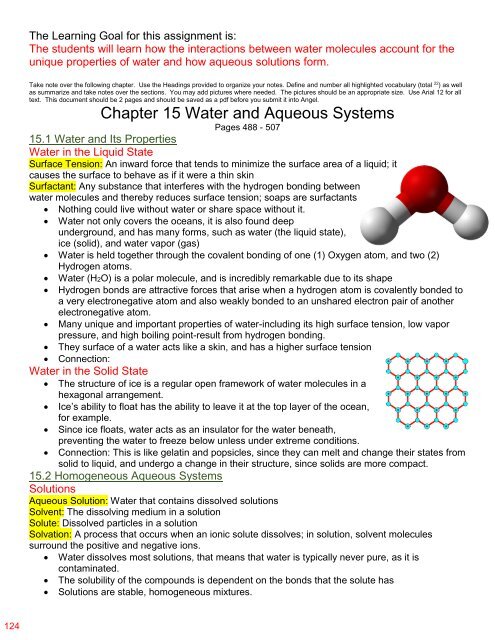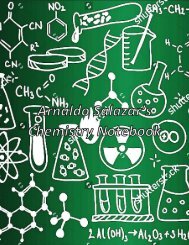Create successful ePaper yourself
Turn your PDF publications into a flip-book with our unique Google optimized e-Paper software.
The Learning Goal for this assignment is:<br />
The students will learn how the interactions between water molecules account for the<br />
unique properties of water and how aqueous solutions form.<br />
Take note over the following chapter. Use the Headings provided to organize your notes. Define and number all highlighted vocabulary (total 22 ) as well<br />
as summarize and take notes over the sections. You may add pictures where needed. The pictures should be an appropriate size. Use Arial 12 for all<br />
text. This document should be 2 pages and should be saved as a pdf before you submit it into Angel.<br />
Chapter 15 Water and Aqueous Systems<br />
Pages 488 - 507<br />
15.1 Water and Its Properties<br />
Water in the Liquid State<br />
Surface Tension: An inward force that tends to minimize the surface area of a liquid; it<br />
causes the surface to behave as if it were a thin skin<br />
Surfactant: Any substance that interferes with the hydrogen bonding between<br />
water molecules and thereby reduces surface tension; soaps are surfactants<br />
Nothing could live without water or share space without it.<br />
Water not only covers the oceans, it is also found deep<br />
underground, and has many forms, such as water (the liquid state),<br />
ice (solid), and water vapor (gas)<br />
Water is held together through the covalent bonding of one (1) Oxygen atom, and two (2)<br />
<br />
<br />
<br />
<br />
<br />
Hydrogen atoms.<br />
Water (H2O) is a polar molecule, and is incredibly remarkable due to its shape<br />
Hydrogen bonds are attractive forces that arise when a hydrogen atom is covalently bonded to<br />
a very electronegative atom and also weakly bonded to an unshared electron pair of another<br />
electronegative atom.<br />
Many unique and important properties of water-including its high surface tension, low vapor<br />
pressure, and high boiling point-result from hydrogen bonding.<br />
They surface of a water acts like a skin, and has a higher surface tension<br />
Connection:<br />
Water in the Solid State<br />
<br />
<br />
<br />
<br />
The structure of ice is a regular open framework of water molecules in a<br />
hexagonal arrangement.<br />
Ice’s ability to float has the ability to leave it at the top layer of the ocean,<br />
for example.<br />
Since ice floats, water acts as an insulator for the water beneath,<br />
preventing the water to freeze below unless under extreme conditions.<br />
Connection: This is like gelatin and popsicles, since they can melt and change their states from<br />
solid to liquid, and undergo a change in their structure, since solids are more compact.<br />
15.2 Homogeneous Aqueous Systems<br />
Solutions<br />
Aqueous Solution: Water that contains dissolved solutions<br />
Solvent: The dissolving medium in a solution<br />
Solute: Dissolved particles in a solution<br />
Solvation: A process that occurs when an ionic solute dissolves; in solution, solvent molecules<br />
surround the positive and negative ions.<br />
Water dissolves most solutions, that means that water is typically never pure, as it is<br />
contaminated.<br />
The solubility of the compounds is dependent on the bonds that the solute has<br />
Solutions are stable, homogeneous mixtures.<br />
124




